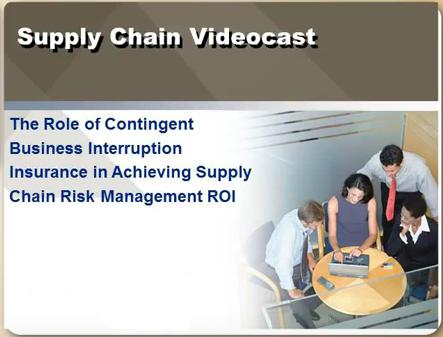To ensure effective supply chain risk management (SCRM) and best achieve the ROI that comes with such programs, companies must address all elements of their supply chain operations management.
In our most recent videocast, Vonnie French, Vice President of Supply Chain Operations at Palo Alto Networks, discusses the company’s strategy for leveraging Contingent Business Interruption (CBI) insurance to help manage supply chain risk.
Can you give a little background on Palo Alto Network’s SCRM program?
We were initially introduced to Resilinc and the SCRM program through our manufacturing partner around the same time that the earthquake and tsunami hit Japan in March 2011. The ability to quickly assess our supply chain and determine any impact to our business was extremely critical. Supply chain risk and business continuity are extremely important to all companies and even more so to us in 2012 prior to our IPO. The decision to engage directly with a partner like Resilinc to help in our effort to ensure business continuity and in developing a resilient supply chain became a strategic imperative for us.
What does the annual insurance process look like?
The supply chain operations management plays a key role in the contingent business interruption insurance process every year. A well-thought-out supply chain with deep visibility into potential disruptions makes insurance carriers involved much more comfortable with the risk.
Understanding the steps taken to minimize potential catastrophic loss (essentially leading to insurance company payouts) provides comfort to insurance carriers offering higher limits than what might normally be offered to a less desirable risk.
All insurance carriers worry about aggregation of exposures at contract manufacturing facilities. The depth of data we are able to provide—regarding options, quantification of exposure, the strong relationship we have with our contract manufacturer and the SCRM program we have in place—makes us stand out among other companies who may be vying for the insurance companies’ attention and capacity.
The benefit of the program that we have put in place is that it allowed our insurance broker to help the insurer better quantify the true exposures we face and, by extension, gives the carrier greater comfort in providing adequate limits at a competitive premium.
Give us the holistic program perspective. Where to begin, who are the key stakeholders?
The overall holistic view at the supply chain level with the focus on the continuity of the supply encompasses the visibility into the supply chain beyond the first and second tier of suppliers, which would be both manufacturers and directly controlled suppliers.
It is vital to collect the manufacturing location, information about that specific location (i.e., geographical location, government influence, and the ability and timeline for that location to be back at full operations post-disruption).
The other item that we need to consider is the financial stability of the suppliers within our supply chain and their dependencies on their own supply chain.
All this information assists us to manage and proactively mitigate risks that could impact the top line of our business.
The key stakeholders in these initiatives are made up from the various functions within Operations, which includes Supply Chain Resiliency, Supply Base Management, and Engineering. Hardware Engineering is part of the core team for product development.
How do you collectively quantify exposure?
From a risk perspective, we quantify exposure with potential lost billings along with costs for recovery, for example, pre-paid inventory, freight costs, etc.
What is your organization’s expectation with regard to Contingent Business Interruption insurance?
The amount of investment the business will make to mitigate risk is based on its exposure threshold, so, how much exposure is really acceptable. Insurance is in place to close the gap for a potential loss of revenue outside of the mitigated exposure.
How does a solution such as Resilinc’s provide value?
Resilinc and other similar tools we use are outsourced services that identify the supply chain risks down to the part number or manufacturing site. The data collected is the basis for mitigation planning and execution. This information also is used for disaster recovery planning and business impact analysis. They provide proactive notification of risk issues to resolve before they impact the business.
What results or benefits can you share?
Proactively assessing product risk during development has significantly reduced the number of parts that could impact product prior to release or potential production line down situations.
If you had to add one item to your wish list, what would it be?
Collecting data beyond the tier 1 or 2 suppliers to help us identify risk further down the supply chain.
To learn more about SCRM and how risk mitigation tools and practices can help companies better garner ROI, view the videocast, “The Role of Contingent Business Interruption Insurance in Achieving Supply Chain Risk Management ROI.” The videocast features a world-class panel including Gary Lynch, CEO at The Risk Project, Brian Jenkins, Risk Financing Manager at General Motors, Vonnie French, VP, Supply Chain Operations at Palo Alto Networks, Bindiya Vakil, CEO at Resilinc, and Supply Chain Digest’s Dan Gilmore.





